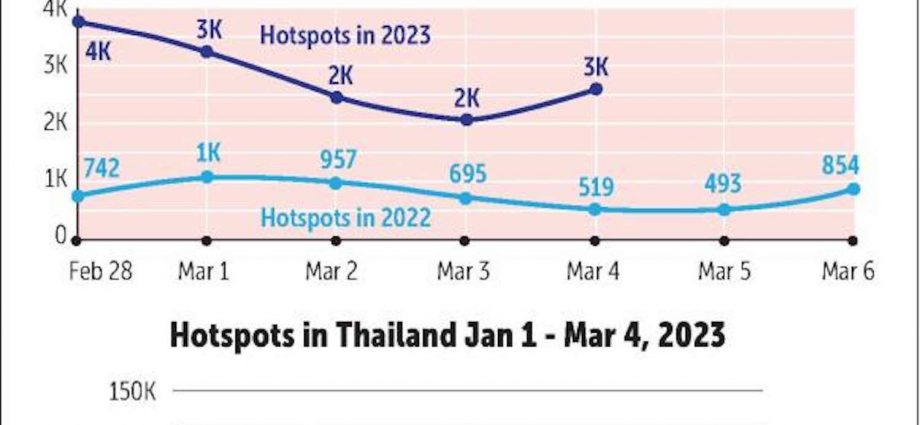Unsafe PM2.5 levels across 36 provinces

Haze pollution is exceeding safe levels in 36 provinces, particularly in the North, while Bangkok and surrounding provinces will remain blanketed in smog for two more days.
Jatuporn Buruspat, permanent secretary for the Ministry of Natural Resources and Environment, said on Monday that ultra-fine dust particles (PM2.5) have remained at critical levels in the North and the Northeast for the past week, as a result of slash-and-burn activities in forests and farms with more than 2,500 hotspots found on both sides of the border.
Officials from the Department of Natural Parks, Wildlife, and Plant Conservation, the Royal Forest Department and local officials are struggling to control the blazes, he added.
Mr Jatuporn said that the Asean Secretariat had alerted the bloc’s members of the hotspots in their countries, in an attempt to enlist their cooperation in helping to deal with the problem.
He said the National Environment Board would meet on March 15 to discuss measures to bring forest fires under control as quickly as possible.
According to the Geo-Informatics and Space Technology Development Agency (Gistda), Suomi NPP satellite images showed 6,701 hotspots in Myanmar, 2,583 in Thailand, 2,125 in Cambodia, 1,434 in Laos, 147 in Vietnam, and two in Malaysia on Saturday alone.
Thawatchai Sanyakit, a member of a wildfire fighting unit in Phitsanulok, said a forest fire was detected in the Mae Ping National Park in Lamphun’s Li district at about 2am on Monday.
The team moved in to control the fire and found that about 70 rai of forested land had been razed in the fire believed to have been caused by human activities.
Atthapol Charoenchansa, acting director-general of the Department of Natural Parks, Wildlife, and Plant Conservation, on Monday announced the closure of 38 national parks, eight areas prepared to be designated as national parks, 11 forest parks, 20 wildlife conservation parks, and two non-hunting areas, as part of measures to prevent potential wildfires.
According to the Pollution Control Department (PCD) director-general Pinsak Suraswadi, joint checkpoints inspected 109,696 vehicles in Bangkok in the six months between October last year and Feb 28.
Of them, a total of 23,707 were releasing exhaust fumes that breached regulations on toxicity, he said.
Further checkpoints have been set up by traffic police, the Bangkok Metropolitan Administration and the Department of Land Transport to inspect trucks, public buses and other vehicles for any excess black smoke emissions, he said.
“Vehicles belching levels of pollutants that fail standard emissions tests will be suspended from use, and their owners asked to fix the problem before they are allowed back on the road,” he said.
According to the Centre for Air Pollution Mitigation, PM2.5 pollution exceeded-safe levels in 36 provinces, mostly in the North and the Northeast, on Monday, with dust levels above the government’s safe limit of 50 microgrammes per cubic metre (μg/m³).
As of 7am, PM2.5 levels ranged between 53-132μg/m3 in most areas in the North, 32-78μg/m³ in three areas in the Northeast, 32-68μg/m³ in six areas in the Central Plains and the West, 40-57μg/m³ in four areas in the East, and 16-33ug/m³ in the South.
In Bangkok and surrounding areas, atmospheric PM2.5 ranged from 41-77μg/m³.
The PCD’s air management division has predicted that PM2.5 levels will rise in some areas in Bangkok and surrounding provinces today and tomorrow, and the situation will improve from Thursday onwards as the wind from the South blows the dust away from the areas.
However, over the coming week, PM2.5 levels are expected to rise in 17 provinces in the upper and lower North, according to the PCD’s air management division.


